Adresse Ministãƒâ¨re Des Arts Et De La Culture Du Cameroun Wikipedia
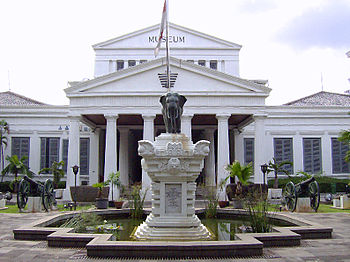
The National Museum of Indonesia in Jakarta, the oldest cultural society in Indonesia, was established in 1778. The building in the photo, the second edifice of the museum'southward society, was also the oldest museum building in Indonesia, dating from the 19th century.
This listing includes many museums and cultural institutions in Republic of indonesia (including aquariums, zoos, and botanical gardens, following the definition of the International Quango of Museums).
Heritage buildings such as candi, mosques, colonial churches and buildings with no site museum should non exist placed in the listing.
History [edit]
Colonial flow [edit]


The library of the Batavia Gild of Art and Science. The baroque bookcase in the picture is still kept in the Jakarta History Museum as of 2012, although under lack of standardized museum maintenance.
Before the 20th-century, there was trivial involvement in the written report of the native culture of Republic of indonesia by the colonial regime. Nigh anthropologic studies were washed past a few non-governmental institutions and individuals. Amid the non-governmental institution was the Batavian Society of Arts and Science, which established a museum for Indonesian civilisation and history. Individuals due east.k. Sir Stamford Raffles and Dr. Snoeck Hourgrogne wrote valuable studies on native civilisation and history earlier the 20th-century.[i]
The first museum in Republic of indonesia seems to have been that congenital past Rumphius in Ambon, built in 1662. Nothing remains of it except books written by himself, which are now in the library of the National Museum. Its successor was the Batavia Lodge of Fine art and Science, established on April 24, 1778. It built a museum and a library, played an of import role in research, and collected much fabric on the natural history and culture of Indonesia. It afterward came under the direct control of the British Lieutenant-Governor Raffles who, among other things, provided it with a new function building for the museum and library administration. The museum collection and library continued to abound, and in 1862 the government built, in the center of New Batavia, what is now the National Museum, the previous building is now Wayang Museum in Dki jakarta Old Town. The whole collection was transferred to the Government of the Democracy of Republic of indonesia in 1962.[2]
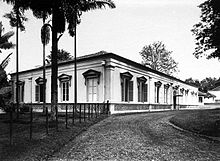
The Batavia Society of Art and Scientific discipline as well specialized in social sciences. In 1817 information technology made the plans for the Hortus Botanicus Bogoriense in Bogor. In 1894 it set upward the Museum Zoologicum Bogoriense. The Bibliotheca Bogoriense made Bogor into an important heart of biological scientific discipline.[ii]
Except for the Radya Pustaka Museum in Surakarta (1890), no other major museums were established in the 19th century. It was just in the 1930s that local museums began to appear, usually privately initiated, past civil servants and Catholic and Protestant missionaries. These museums are praiseworthy, but are not always in good hands, and are often run by boards which do not always function continually.[2] Some museums suffer from the lack of regular resource, and some have disappeared completely, e.one thousand. the Karo Museum in Berastagi, North Sumatra, set up past Dr Neuman, was abolished during the Japanese occupation (1942–45); and the Banjarmasin Museum built by Dr Malinkrodt, an practiced on customs and traditions in Kalimantan, was burned down.[2]
At the beginning of the 20th century, the colonial government became interested in the maintenance and restoration of cultural remains. In 1901 it set upwardly the Commissie in Nederlandsch Indie voor Oudheidkundige Onderzoek van Coffee en Madoera, headed by Dr J. Fifty. A. Brandes. In 1913, this became the more effective Oudheid-kundige Dienst van Nederlandsch Indie (Archaeological Service), under Professor Dr. N.J. Kromm. The government likewise employed officials to make a study of local languages and started the Kantoor voor Inlandsche Zaken.[1]
In 1918 Balai Poestaka was created to publish books of literary value in Malay and local languages. Malay was taught in schools next to the local language. Prospective civil servants were obliged to report the linguistic communication and community of the region they were to work in. Grooming was given in Leiden, in the Netherlands. Native Indonesians also came to realize the importance of their national culture in awakening nationalism, part of a general contemporary phenomenon in Asia. This nationalism was pioneered by Budi Utomo in 1908 in the STOVIA, whose building, the School for Javanese Doctors, is converted into a museum today.[1]
Mod technology and cultural change leads to disappearance of ethnic handicrafts. There was no longer a market for plait-work, textiles, earthenware, and brass, silver and gold objects. The result was a gradual process of cultural impoverishment. A need for money forced people to sell their heirlooms on the market, and many objects that should accept been kept in Indonesia found their manner to foreign countries. This condition prompted the building of the Sana Budaya Museum in Yogyakarta in 1935. Dr. F. D. K. Bosch, then Caput of the Archaeology Service, and now Museum Managing director of the Batavia Society, first referred to cultural impoverishment, and the demand for historical and cultural museums, to encourage people to capeesh their own products and to improve the quality of their handicrafts.[ii]

The gate of Bali Museum, built in 1931 by architect P.J. Moojen, nigh the location of the former royal palace of Denpasar, which had been burnt to the ground during the Dutch intervention in Bali (1906).
The late Director of the Municipal Museum of Surabaya, Von Faber, emphasized the function of museums in didactics. The famous painter, Walter Spies, actively helped in the creation and management of the Bali Museum in Denpasar. Unfortunately, the decision to establish museums at the time was not matched past a determination to find experts capable of managing them properly. Simply a few language experts like Professor Husein Jayadiningrat and Professor Dr. Purbacaraka were interested in museums-mainly considering the academy produced few experts in history and the social sciences, but full-bodied on training physicians, lawyers, technicians and civil servants. It was not until independence that the social sciences began to develop.[two]
Japanese occupation [edit]
During the cursory period of Japanese occupation between 1942 and 1945, there was a stimulation on Indonesian culture.[i] 1 of the cultural society established by the colonial Japanese authorities was the Keimin Bunka Sidosho or KBS in 1943. The core policy of the KBS is to promote the cultural unity of the "Greater East asia". Agus Jaya was appointed every bit caput of the arts, Usmar Ismail every bit caput of film and drama, Armijn Pane as head of literature, and Ibu Sud as caput of dance and singing. The KBS actively held exhibitions and performances in big cities of the Japanese-occupied Dutch East Indies. During the three-and-a-half years of Japanese occupation, the Indonesian arts flourish with dozens of fine art exhibitions, performances, and awards. Amongst local artists member of the KBS were Emiria Sunassa, Henk Ngantung, Agus Djaja Suminta, Kartono Yudokusumo, Dullah, Basuki Resobowo, Sudiardjo, Otto Djaja, Subanto, Abdulsalam, Suyono, Surono, Siauw Tik Kwie, Ong Lian Hong, Tan Sun Tiang, Liwem Wan Gie, Harijadi S, Tan Liep Poen, Sukardi, Affandi and S. Tutur.[3]
Another movement founded past the Japanese government was the People'due south Power Movement (Poesat Tenaga Rakjat, Poetera) on March nine, 1932.[iv] Even though Poetera was largely a political organization, the motility had its own cultural segmentation, with native artist Sodjojono appointed as the head of the fine arta and cultural division.[5] [half dozen] [1]
Postal service-independence [edit]
The newly independent government of Indonesia established the Ministry of Instruction and Culture in accordance with Article 32 in the 1945 Constitution. The Section of Culture was divided into Archaeological, Fine art, and Language Divisions. The Fine art Division ready up several educational institutions including the Indonesian Academy of Fine Arts in Yogyakarta (1950), the Indonesian School of Music in Yogyakarta (1952), and Karawitan Conservatoire in Surakarta (1950). In 1952, The Linguistic communication Division was split into two, the first one retained the same name and the same position in the Department of Culture, the other was included in the Found of Literature (former Instituut voor Taal en Cultuur Onderzoek, Faculteit der Lettera en Wijsbegeerte van de Universiteit van Indonesia). Also in 1952, the Section of Culture opened provincial "cultural offices" in Medan (North Sumatra), Bukit Tinggi (Key Sumatra), Palembang (Due south Sumatra), Jakarta, Bandung (West Java), Surabaya (East Java), Makassar (S Sulawesi), Denpasar (Bali) and Ambon (Moluccas).[7]
In 1956, there were several changes in the Department of Civilization, which include the additional responsibility of museum management (the Museum Section).[7] Other changes were: the conversion of the Archaeological Division into the autonomous Institute of Archæology; the Language Division in the Institute of Literature became the Language Partitioning of the Literary Faculty of Indonesia; and the Language Division became the Sub-Sectionalisation of Customs and Traditions.[7]
Afterward, the Department of Civilization was included into the Directorate of Culture as part of the ministerial reorganization of the 1960s. The reorganization likewise converted the Museum Department into the democratic National Museum Plant. Following the reorganization, the Ministry of Education and Culture consisted of one Directorate of Culture and four democratic institutes: Archaeology, Language & Literature, National Museums, and History & Anthropology. The responsibility of opening provincial "cultural offices" was given to the Inspectorate of Provincial Culture.[7]
New Order Period [edit]

At the start of the New Order, the regime of Suharto converted the Ministry building of Education and Culture into 5 Directorates-General. The Directorate-General of Culture itself was divided into five directorates: Art, Cultural Instruction, Archaeology & History, Museums, and Language & Literature.[7] Other restructuring occurred in 1969, reducing the Directorates-General into three; this time the Directorate-General of Culture consisted of three directorates: Art, Art Education, and Museums; and four Institutes: National Language, Archeology, History & Anthropology, and Music & Choreography.[8]
The New Order flow besides saw the expansion of the Armed Forces History Center and the encouragement of the evolution of museums of militaristic in nature. One of the reason for military involvement at first is because of the problem of internal divisions. This led to an accepted strategy of promoting shared values and identity across the forces through the apply of a centralized war machine museum for older and younger generations of the soldiers.[nine] Some of these museums for which the Armed Forces was directly responsible are Satria Mandala Armed Forces Museum (opened in 1972), Museum of the Sacred Pancasila Monument (1982), Museum of Eternal Vigilance (1987), Soldiership Museum (1987), and the Museum of Communist Treachery (1993). The drove of these museums feature relics, photographs, and weapons. Dioramas are extensively used by the War machine History Center, whom method was chosen considering of a general lack of perceived value in historical objects in Indonesia as well equally lack of funds.[x]
Expansion [edit]
The number of museums in Indonesia in 1945 was 26 (including aquariums, zoos, and botanical gardens (post-obit the definition of the International Council of Museums). Between 1945 and 1968, this increased to 46. In 2010 at that place were 281 museums in Republic of indonesia,[eleven] 80 of which are Country Museums.[12] At the kickoff of 2015, the number of museums in Indonesia was 325.[13] As of May 2015, Republic of indonesia had 412 museums.[thirteen]
The Directorate for Museums introduced categories for the various drove types: at that place are general and special museums, there are privately maintained and land-run museums, both by the central and provincial governments. Those museums kept by the primal government in the main operate under the administration of the Ministry of Educational activity and Culture. Military museums are supervised by the Defence Ministry.[fourteen]
The most frequent type is the General Provincial Museum (Museum Umum Propinsi) which exists in almost all provincial capitals. These museums commonly consist of several sections: natural history (geological, biology), ethnography, and history. Objects are sometimes flatly arranged in display cases with poor explanations. More recently established museums have already achieved college standards with thoughtful and appealing expositions.[14]
In Indonesia, the increase in the number of museums has non all the same been matched by an increase in quality. Buildings are oftentimes unsuitable for display and for socio-educational activities; competent staffs are lacking; the public does non all the same appreciate the educational role of museums; funds are lacking to maintain collections and extend building; and so on. In that location are not enough museums for 120 meg inhabitants and a large number of State and private universities. Big cities like Djakarta, Medan, Surabaya, Bandung and Semarang need centers for science and culture, and museums as places of study and leisure.[2]
Museums past region [edit]
Jakarta [edit]
Jakarta contains the most museums in Republic of indonesia with over fifty museums inside its 661 foursquare kilometers expanse. The museums in Djakarta cluster around the Fundamental Jakarta Merdeka Foursquare area, Jakarta Sometime Boondocks, and Taman Mini Indonesia Indah.
The Jakarta Quondam Boondocks contains museums that are former institutional buildings of Colonial Batavia. Some of the notable museums are: Jakarta History Museum (erstwhile City Hall of Batavia), Wayang Museum (onetime Church of Batavia), the Fine Art and Ceramic Museum (former Courtroom House of Justice of Batavia), the Maritime Museum (former Sunda Kelapa warehouse), Banking concern Republic of indonesia Museum (former Javasche Bank), and Banking concern Mandiri Museum (former Netherlands Trading Society).
Several museums clustered in central Jakarta effectually the Merdeka Square area include: National Museum of Indonesia, Monas, Istiqlal Islamic Museum in Istiqlal mosque, and Jakarta Cathedral Museum on the second floor of Dki jakarta Cathedral. Also in the central Djakarta surface area is the Taman Prasasti Museum (former cemetery of Batavia), and Textile Museum in Tanah Abang area.
The recreational area of Taman Mini Indonesia Indah in E Jakarta contains almost twenty museums since the 1970s inside its circuitous.
North Jakarta and Chiliad Islands [edit]
- Maritime Museum
- Onrust Archeology Park
Westward Dki jakarta [edit]

- Jakarta Old Town
- Bank Indonesia Museum
- Bank Mandiri Museum
- Fine Fine art and Ceramic Museum
- Jakarta History Museum or Museum Fatahillah
- Wayang Museum
- Djakarta Textile Museum
- Museum Lukisan Universitas Pelita Harapan
- Museum 12 Mei Universitas Trisakti
- The Museum of Modern and Gimmicky Art in Nusantara
Central Djakarta [edit]

- Bentara Budaya Dki jakarta
- Formulation of Proclamation Text Museum (the site where the text of the nation's annunciation of independence was composed in 1945)
- Gedung Joang '45
- Gedung Kesenian Jakarta
- Gedung Mohammad Hoesni Thamrin
- Jakarta Cathedral Museum
- Dki jakarta Planetarium
- Museum of Indonesian History in Monas
- Museum Adam Malik (1985, airtight in 2005)[15]
- Museum Anatomi Fakultas Kedokteran Universitas Indonesia
- Museum Jenderal Besar Abdul Haris Nasution
- Museum Kebangkitan Nasional
- Museum Pers ANTARA
- Museum Puri Bhakti Renatama
- Museum Sasmita Loka Jenderal Ahmad Yani
- Museum Sumpah Pemuda
- National Gallery of Republic of indonesia
- National Museum or Museum Gajah
- Taman Prasasti Museum
Due east Jakarta [edit]
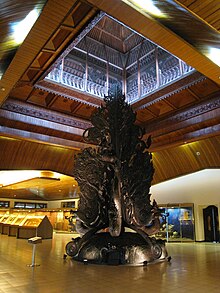
- Museum Loka Jala Srana
- Museum of PKI Treason
- Monument of Sacred Pancasila
- Taman Mini Indonesia Indah
- Asmat Museum
- Indonesian Hakka Museum, formal opening at August thirty, 2014
- Indonesia Museum
- Indonesia Soldiership Museum
- Indonesia Postage Museum
- Insect Museum and Butterfly Park
- Istiqlal Museum
- Komodo Indonesian Brute Museum and Reptile Park
- Museum of Electricity and New Energy
- Museum of Heirloom
- Museum of Lighting
- Museum of Scientific discipline and Technology
- Museum of Telecommunication
- Museum of Transportation
- Oil and Natural Gas Museum
- Purna Bhakti Pertiwi Museum
- Sports Museum
- Timor Timur Museum
Southward Jakarta [edit]
- Basoeki Abdullah Museum
- Harry Dharsono Museum
- Kites Museum of Indonesia
- Museum Dirgantara Mandala
- Museum Kriminal (Mabak)
- Museum Manggala Wanabhakti
- Polri Museum
- Ragunan Zoo
- Reksa Artha Museum
- Satria Mandala Museum
Java [edit]

Banten [edit]
- Benteng Heritage Museum, Tangerang
West Java [edit]
- Amerta Dirgantara Museum, Subang
- Asian–African Conference Museum, Bandung (1980)
- Bandung Geological Museum, Bandung (1928)
- Bandung Zoo, Bandung (1933)
- Barli Museum, Bandung
- Bogor Botanical Garden, Bogor (1817)
- Bogor Zoological Museum, Bogor (1894)
- Cibodas Botanical Garden, Cibodas (1852)
- Ethnobotanical Museum, Bogor
- Indonesia Post Museum, Bandung
- Kraton Kacirebonan Museum, Cirebon
- Kraton Kasepuhan Museums, Cirebon:
- Museum Diorama Bale Panyawangan, Purwakarta (2015)
- Museum Kereta Singa Barong
- Museum Benda Kuno
- Museum Linggarjati, Kuningan
- Museum Palangan B. Kokosan, Sukabumi
- Pembela Tanah Air Museum, Bogor
- Museum Banking concern Republic of indonesia, Bandung
- Museum Perjuangan Jawa Barat, Bandung
- Museum Perjuangan Jawa Barat, Bogor
- Museum Prabu Geusan Ulun, Purwakarta
- Museum Tanah Nasrel, Bogor
- Percandian Batujaya Museum, Karawang
- Sri Baduga Museum, Bandung (1980)
- Tambaksari's Site Museum, Ciamis
- Wangsit Mandala Siliwangi Museum
Central Java [edit]

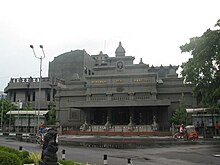
National Museum of Press in Solo.
- Ambarawa Railway Museum, Ambarawa
- Borobudur Complex, Magelang
- Karmawibhangga Museum (1983)
- Samudra Raksa Museum (2005)
- Danar Hadi Batik Museum, Surakarta (2008)
- Indonesian World Records Museum, Semarang
- Keraton Surakarta Museum, Surakarta
- Kretek Museum, Kudus
- National Press Monument and Museum, Surakarta
- Pekalongan Batik Museum, Pekalongan (1972)
- Radya Pustaka Museum, Surakarta (1890)
- Ranggawarsita Museum, Semarang
- Sangiran archaeology museum, Sangiran
- Tumurun Private Museum, Surakarta
Special Region of Yogyakarta [edit]
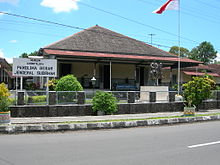
Museum Sasmitaloka Panglima Besar Jenderal Soedirman.
Due to the importance of Yogyakarta during the state of war of independence from the Dutch, there are numerous memorials and museums. Monument Yogya Kembali and Fort Vredeburg Museum are two major museums of about 11 named in the urban center.
- Affandi Museum
- Code Museum
- Dewantara Kirti Griya Museum
- Dharma Wiratama Museum
- Dirgantara Mandala Museum
- Fort Vredeburg Museum
- Gembira Loka Zoo
- Jogja National Museum
- Kraton Yogyakarta Museum
- Hamengkubuwono 9 Museum
- Train Museum
- Monumen Pahlawan Pancasila
- Museum Batik "Ciptowening"
- Museum Karbol TNI Angkatan Udara
- Museum Kayu Wanagama
- Museum Kebun Raya Gembira Loka
- Museum of Biology Gadjah Mada University
- Museum of Geotechnology and Mineral
- Museum Pergerakan Wanita
- Museum Perjuangan Yogyakarta
- Museum Purbakala Pleret
- Museum Pura Paku Alaman
- Museum R.S. Mata "Dr. Yap"
- Museum Tani Jawa Republic of indonesia
- Museum Tembi (Rumah Budaya Tembi)
- Nyoman Gunarsa Museum
- Prambanan Museum
- Museum Sasmitaloka Panglima Besar (Pangsar) Jenderal Sudirman
- Sonobudoyo Museum (1939)
- Sasana Wiratama
- Taman Budaya Yogyakarta
- Museum Anak Kolong Tangga
- Ullen Sentalu Museum
- Wayang Kekayon Museum
- Yogyakarta Batik Museum
- Yogya Kembali Museum, Sleman Regency
- Museum Sandi
East Coffee [edit]
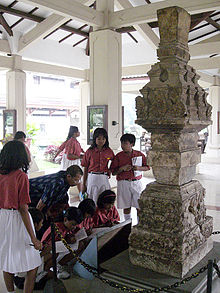
School children in Trowulan Museum.
- 10th November Museum, Surabaya
- Airlangga Museum, Kediri
- Batu Surreptitious Zoo, Batu
- Brawijaya Museum, Malang
- Health Museum of Dr. Adhyatma, Surabaya
- House of Sampoerna, Surabaya
- Mpu Tantular State Museum, Buduran, Sidoarjo
- Museum Bank Indonesia, Surabaya
- Museum Malang Tempo Doeloe (Adept erstwhile times), Malang
- Museum Mpu Tantular, Surabaya
- Submarine Monument, Surabaya
- Surabaya Zoo, Surabaya
- Trowulan Museum, Trowulan (1987)
Lesser Sunda Islands [edit]
Bali [edit]
- Agung Rai Museum of Art
- Bali Botanic Garden, Bedugul (1959)
- Bali Museum (1930)
- Blanco Renaissance Museum
- Buleleng Museum, Singaraja
- Le Mayeur Museum, Sanur
- Museum Pasifika
- Museum Rudana
- Museum Semarajaya
- Neka Fine art Museum, Ubud (1982)[16]
- Purbakala Archaeological Museum
- Puri Lukisan Museum
West Nusa Tenggara [edit]
- West Nusa Tenggara State Museum (1982)
E Nusa Tenggara [edit]
- East Nusa Tenggara Country Museum
Sumatra [edit]
Most museums in Sumatra are ethnographic musea specializing in cultural heritage e.g. textiles and other traditional artifacts.
Aceh [edit]


- Aceh Museum, Banda Aceh (1915)
- Aceh Seismic sea wave Museum, Banda Aceh (2009)
- Cut Nyak Dhien Mansion Museum
- Museum Malikussaleh, Lhokseumawe
Due north Sumatra [edit]
- Batak Museum, Balige
- Maimun Palace Museum, Medan
- Museum Huta Bolon Simanindo, Simanindo
- Museum Joang '45, Medan
- Museum Perjuangan TNI Kodam I Bukit Barisan, Medan (1971)
- Museum Rumah Bolon Pematang Purba, Pematang purba
- Museum Simalungun, Pematangsiantar (1940)
- Nias Heritage Museum, Gunungsitoli (1991). The merely museum in Nias, was destroyed past the Boxing Day Tsunami. A new building for the museum has been constructed.
- North Sumatra Museum, Medan (1982)
- Sumatran Numismatic Museum, Medan (2017)
- TB Silalahi Centre, Balige Subdistrict (2008)
- Tjong A Fie Mansion Museum, Medan
- Zoological Museum of Pematangsiantar, Pematangsiantar (1936)
Riau Province and Riau Islands [edit]
- Bagansiapiapi Chinese Museum, Bagansiapiapi
- Bagansiapiapi Fish Museum, Bagansiapiapi
- Bagansiapiapi History Museum, Bagansiapiapi
- Bagansiapiapi Muslim Museum, Bagansiapiapi
- Museum Kandil Riau, Tanjung Pinang (1988)
- Museum Sang Nila Utama, Pekanbaru (1994)
- Siak Sri Indrapura Palace Museum, Indrapura (Building from 1889)
- Museum Sultan Sulaiman Badrul Alamsyah, Tanjung Pinang
West Sumatra [edit]

- Adityawarman Museum, Padang (1977)
- Bung Hatta Museum, Bukittinggi
- Buya Hamka Birthplace Museum, Agam (2001)
- Tri Daya Eka Dharma Museum, Bukittinggi
- September 30, 2009 Earthquake Museum, Padang (2012)
- Gedung Joang '45, Padang
- Goedang Ransoem Museum, Sawahlunto
- Galeri Tambang Mbah Soero, Sawahlunto
- Information Center of Minangkabau Culture, Padang Panjang (1990)
- Museum Rumah Adat Baanjuang, Fort de Kock, Bukittinggi
- Railway Museum, Sawahlunto
- Museum Taman Bundo Kandung, Bukittinggi (1934)[17]
- Museum Tri Daya Eka Dharma, Bukittinggi (1973)
- Bukittinggi Zoological Museum, Bukittinggi
- Pagaruyung Palace Museum
- Rumah Puisi Taufiq Ismail, Tanah Datar
- Rumah Kelahiran Tan Malaka, Lima Puluh Kota
- Rasuna Said Mansion Museum
Bengkulu [edit]
- Bengkulu Country Museum
- Fort Marlborough, Bengkulu Urban center
Jambi [edit]
- Jambi Museum, Jambi City (1988)
- Muaro Jambi Temple Compounds Site Museum, Muaro Jambi Regency
- Museum Perjuangan Rakyat Jambi, Jambi City (1993)
South Sumatra and Bangka–Belitung Islands [edit]

- Al-Qur'an Al-Akbar Museum
- Balaputradeva Museum, Palembang
- Museum Monpera, Palembang
- Museum UPT Belitung, Belitung
- Sriwijaya Kingdom Archaeological Park, Palembang
- Sultan Mahmud Badaruddin Ii Museum, Palembang
- Textile Museum, Palembang
- Word Museum, Belitung
Lampung [edit]
- Ruwa Jurai Museum, Bandar Lampung (1988)
Kalimantan [edit]
Most museums in Borneo specialized on cultural heritage such every bit textiles and other traditional artifacts. In S Borneo, most museums are shaped similar the traditional Banjar house.
Central Kalimantan [edit]
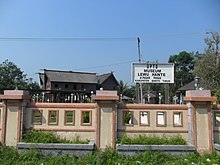
- Balanga Museum, Palangkaraya
- Kayu Sampit Museum, East Kotawaringin Regency
- Lewu Hante Museum, Pasar Panas, East Barito Regency
North Kalimantan [edit]
- Bulungan Sultanate Museum, Bulungan Regency
East Borneo [edit]
- Kalimantan Art Gallery, Samarinda
- Mulawarman Land Museum, Tenggarong Subdistrict
- Museum Batiwakkal, Gunung Tabur Subdistrict, Berau Regency[xviii]
- Museum Kayu Tuah Himba, Tenggarong Subdistrict
- Museum Perjuangan Merah Putih, Sanga-Sanga Subdistrict
- Sadurengas Museum, Paser Belengkong Subdistrict[19]
- Sendawar Museum, West Kutai Regency[20]
South Kalimantan [edit]

Wasaka Museum in Banjarmasin.

Candi Agung Museum in Amuntai town.
- Candi Agung Museum, Amuntai, North Hulu Sungai Regency
- Lambung Mangkurat Land Museum, Banjarbaru
- Wasaka Museum, Banjarmasin
West Borneo [edit]
- West Kalimantan State Museum, Pontianak
- Museum Dara Juanti, Sintang[21]
- Museum Istana Kadriyah, Pontianak[22]
- Museum Kapuas Raya, Sintang[23]
Sulawesi [edit]
Most museums in Sulawesi specialize in cultural heritage such as textiles and other traditional artifacts.
North Sulawesi [edit]
- Manado Wanua Paksinata North Sulawesi Provincial Museum, Manado
Primal Sulawesi [edit]
- Kaili Souraja Museum, Kaili
- Palu Fundamental Sulawesi Provincial Museum, Palu
South Sulawesi [edit]
- Museum Batara Guru, Wara Utama Subdistrict
- Museum Indo' Ta'dung, Kete Kesu, Toraja Utara
- Museum La Galigo, Fort Rotterdam, Makassar
- Sungguminasa Balla Lompoa Museum, near Ujung Pandang
Southeast Sulawesi [edit]
- Buton Palace Museum, Baubau, Buton Island
- Southeast Sulawesi State Museum, Kendari
The Moluccas [edit]
Ambon was the site of the first recorded museum in Republic of indonesia, a botanical museum built by Georg Eberhard Rumphius in 1662. Nothing remains of it except books written past himself, which are now in the library of the National Museum of Indonesia.
Today, museums in the Moluccas specialize in Ambonese ethnography or artifacts from the before Sultanates in the Moluccas.
Maluku [edit]
- Siwa Lima State Museum, Ambon (1973)[24]
Maluku Islands [edit]

- Kedaton Sultan Ternate Museum, Kota Ternate Utara Subdistrict, Ternate (1982)[25]
- Sonyie Malige Museum, Tidore[26]
- World War Ii and Trikora Museum, Morotai
Papua [edit]
Papua province [edit]
- Asmat Museum of Civilization and Progress, Agats (1973)
- Loka Budaya Museum, Cenderawasih University, Jayapura (1973)[27]
- Papua Province Country Museum, Jayapura (1983)[28]
Encounter too [edit]
- Tourism in Indonesia
- Culture of Indonesia
- List of museums
References [edit]
- ^ a b c d e Ministry of Education & Culture of the Republic of Indonesia 1973, pp. 14–7.
- ^ a b c d due east f grand Ministry of Didactics & Civilisation of the Republic of Republic of indonesia 1973, pp. 29–33.
- ^ "KEIMIN BUNKA SHIDOSO". Ensiklopedi Jakarta. Dinas Komunikasi, Informatika dan Statistik Pemprov Dki jakarta. 2017. Retrieved June sixteen, 2018.
- ^ Jones 2013, p. 62.
- ^ Jones 2013, p. 64.
- ^ Bentara Budaya Dki jakarta 2008, p. 277.
- ^ a b c d e Ministry of Education & Culture of the Republic of Indonesia 1973, p. 15.
- ^ Ministry of Education & Civilization of the Commonwealth of Indonesia 1973, pp. 15–7.
- ^ McGregor 2007, pp. 111–2.
- ^ McGregor 2007, pp. half dozen–10.
- ^ Ruslan Burhani (2010). "Sebagian Besar Museum Indonesia Kurang Interaktif". Antara News (in Indonesian). Retrieved February 18, 2013.
- ^ "Jumlah Pengunjung Museum di Republic of indonesia" (PDF). Pusat Pengelolaan Information dan Sistem Jaringan (in Indonesian). BAPPENAS, Depbudpar. 2009. Archived from the original (PDF) on June 21, 2012. Retrieved February 18, 2013.
- ^ a b Susi Ivvaty (May 23, 2015). "Surga Artefak yang Merawat dan Mengembangkan Gagasan" (in Indonesian). Kompas. p. 12.
- ^ a b Sri Kuhnt-Saptodewo (1997). Nationalism and cultural revival in Southeast Asia: perspectives from the center and the region. Otto Harrassowitz Verlag. pp. 99–118. ISBN9783447039581 . Retrieved May 26, 2013.
- ^ "Adam Malik, Museum". Dki jakarta.go.id. Ensiklopedi Jakarta. 2010. Retrieved May six, 2013.
- ^ Agus Aris Munandar (2011). Sejarah Permuseuman di Indonesia (in Indonesian). Direktorat Permuseuman.
- ^ Vaisutis, Justin (2007). Indonesia. Lonely Planet. p. 443. ISBN9781741044355 . Retrieved February 18, 2013.
- ^ "Museum Gunung Tabur". Asosiasi Museum Indonesia. Asosiasi Museum Republic of indonesia. 2013. Retrieved November 21, 2013.
- ^ "Museum Sadurengas". Asosiasi Museum Indonesia. Asosiasi Museum Indonesia. 2013. Retrieved Nov 21, 2013.
- ^ "Museum Sendawar". Asosiasi Museum Indonesia. Asosiasi Museum Indonesia. 2013. Retrieved November 21, 2013.
- ^ "Museum Dara Juanti". Asosiasi Museum Indonesia. Asosiasi Museum Indonesia. 2013. Retrieved November 21, 2013.
- ^ "Museum Istana Kadriyah". Asosiasi Museum Indonesia. Asosiasi Museum Indonesia. 2013. Retrieved November 21, 2013.
- ^ "Museum Kapuas Raya". Asosiasi Museum Republic of indonesia. Asosiasi Museum Indonesia. 2013. Retrieved November 21, 2013.
- ^ "Museum Negeri Provinsi Maluku Siwa Lima". Asosiasi Museum Indonesia. Asosiasi Museum Indonesia. 2013. Retrieved November 21, 2013.
- ^ "Museum Kedaton Sultan Ternate". Asosiasi Museum Indonesia. Asosiasi Museum Republic of indonesia. 2013. Retrieved Nov 21, 2013.
- ^ "Museum Sonyie Malige". Asosiasi Museum Indonesia. Asosiasi Museum Indonesia. 2013. Retrieved Nov 21, 2013.
- ^ "Museum Loka Budaya Universitas Cenderawasih". Asosiasi Museum Republic of indonesia. Asosiasi Museum Republic of indonesia. 2013. Retrieved Nov 21, 2013.
- ^ "Museum Negeri Provinsi Irian Jaya". Asosiasi Museum Republic of indonesia. Asosiasi Museum Republic of indonesia. 2013. Retrieved November 21, 2013.
Cited works [edit]
- Bentara Budaya Jakarta (2008). The Journey of Indonesian Painting: The Bentara Budaya Collection. Kepustakaan Populer Gramedia. ISBN9789799101204.
- Directorate-Full general of Culture, Ministry of Instruction & Culture of the Democracy of Indonesia (1973). Cultural Policy in Indonesia (PDF). Paris: UNESCO. Retrieved February 17, 2013.
- Jones, Tod (2013). Culture, Power, and Authoritarianism in the Indonesian Country: Cultural Policy across the Twentieth Century to the Reform Era. Southeast Asia Mediated. BRILL. ISBN9789004255104.
- McGregor, Katharine E. (2007). History in Compatible: Military Credo and the Construction of Indonesia's Past. Singapore: NUS Printing. ISBN9789971693602.
External links [edit]
- Directory of Museums in Indonesia
- "Seni Rupa Indonesia pada Masa Pendudukan Jepang". Seni Budaya Smasa. Wordpress. October 7, 2013. Archived from the original on June 16, 2018. Retrieved June sixteen, 2018.
chaffeythounater44.blogspot.com
Source: https://en.wikipedia.org/wiki/List_of_museums_and_cultural_institutions_in_Indonesia